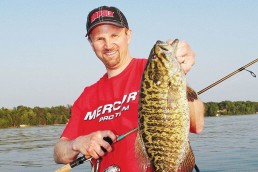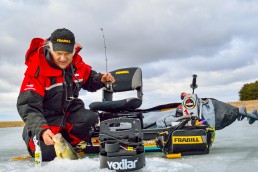Sinkin’ Slow with new-style Traditional Worms
SHARE THIS POST
Through late spring and summer, slow-sinking, traditional plastic worms suit largemouths and smallmouths that don’t chase after fish forage. Many of us prefer Senko-style worms rigged wacky or with a worm hook, but these fat-bodied treats sink twice as fast as some of the others.
Since most of the time I pitch to submerged brush, limbs and tree trunks, a 15-pound-test quality braid is a must. And one without a barrel swivel to attach to I’ll use a 15-pound-test fluorocarbon leader. A uni-to-uni splice keeps weight minimal—no split shot, no worm weight, nothing. Bass have even slurped plastic off the surface because I can lift the worm and let calm-water tension catch and support the offering as a very subtle topwater presentation.
I choose skinnier worms than most of the older brands from the 1970s, ones without twister or paddle tails. A straight line narrowing to a relatively thin tail allows the rear to lift slightly on descent—that’s all the action that’s needed. The idea is to eliminate “attractions,” like twister tails. Bass can sense the undulation of twisters through their lateral line organs, and sometimes they will not strike in reaction no matter what you do. They’re also turned off by too much sensory input if they get distracted in the midday sun. We do well by finesse worming, even in the blazing June and July heat. And we never use worms with anything added to a straight simple style, besides scent. At such a slow rate of descent, my favorite garlic can make all the difference.
Contrary to the typical “bipolar” notion about bass either feeding or not, they will eat almost any time they’re awake during the warm-water months. Feeding is not an issue, but it is a function of how active the pursuit is. Most of the time feeding is real slow because bass resist quick reactions in order to keep calories in their bodies rather than expend them. The warmest water temperatures of the year eventually occur, and their cold-blooded metabolism is so overdrawn that they don’t move much. But they’ll eat if the take is easy, and, at any time of the day.
Are you enjoying this post?
You can be among the first to get the latest info on where to go, what to use and how to use it!
I’ve made catches on weightless slow worms as deep as 17 feet at the outer edge of a weed bed, but most of this fishing is 8 feet deep or shallower. Best of all, combinations of weeds and timber, whether fallen trees, submerged brush or stumps, attract forage of all sorts. Summertime is a smorgasbord and bass wait to take small tidbits, even insects. And if a 7 1/2-inch worm drops by, it’s very likely a bass will pounce. Bass retreat into very dense vegetation too if available, so ideally a lake hasn’t got cover so thick that weightless worms become impractical. I know guys who punch holes in “thick salad” with heavy tungsten worm weights. And I own some, but I’ve never used any.
If I’m after smallmouths, weeds among rocks usually don’t hurt if the vegetation improves the odds a little, drawing insects and other forage close. I usually fish in the 12- to 15-foot range among the biggest jagged boulders I find. Although, more often than not during summer lake smallmouths stage deeper and jigs fish them better. This is not so in streams and rivers with a myriad of structural opportunities. Look for moderately deep basins of long, slow stretches as the best spots for slow worms.
Two ways to rig depend on cover, or lack of it. If weeds sparsely populate a cove without timber for bass to tangle in or where rocks seem barren of weeds or other snags, all you need is a medium-power spinning outfit, 6-pound-test monofilament and a size 1 or 2 plain shank hook. Otherwise, use the same spinning outfit, but go with that 15-pound-test quality braid, a 3/0 inset worm hook and always tie a uni-to-uni splice between the braid and that 15-pound fluorocarbon. Fluorocarbon is relatively invisible and resists abrasions. The worm hook has plenty of weight, so choose the lightest wire hook you can find. The absence of a barrel swivel isn’t only about weight, but it’s also about having less junk between you and the bass—and less of a distraction.
MWO
SHARE THIS POST
Did you enjoy this post?
You can be among the first to get the latest info on where to go, what to use and how to use it!
Bruce Edward Litton
MidWest Outdoors works with more than 200 outdoor experts each year, who contribute articles based on their areas of expertise. MidWest Outdoors magazine offers more fishing and hunting articles than any other publication!



